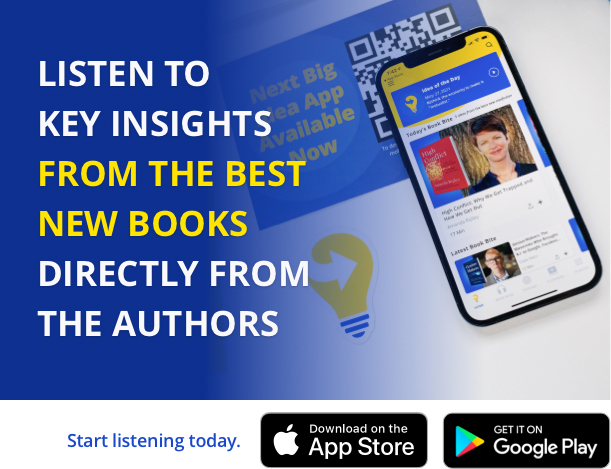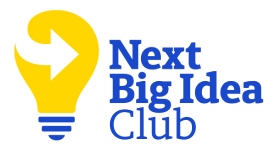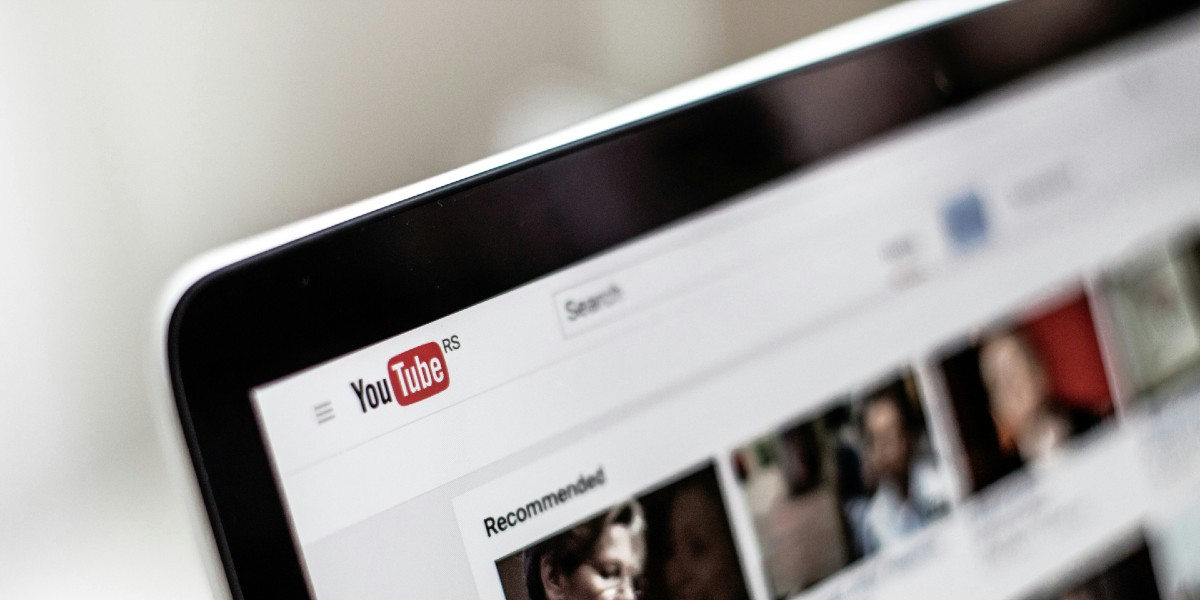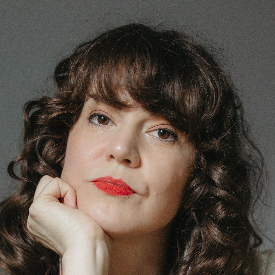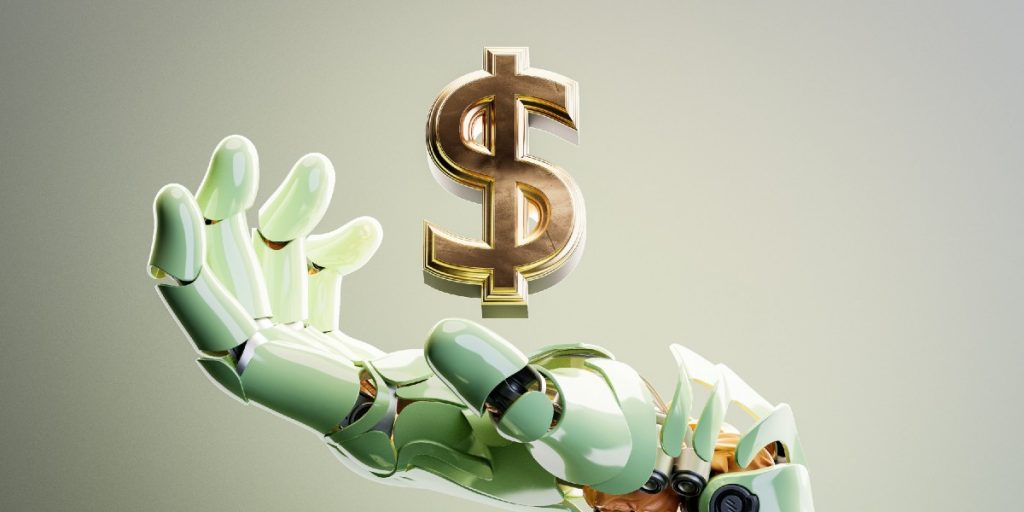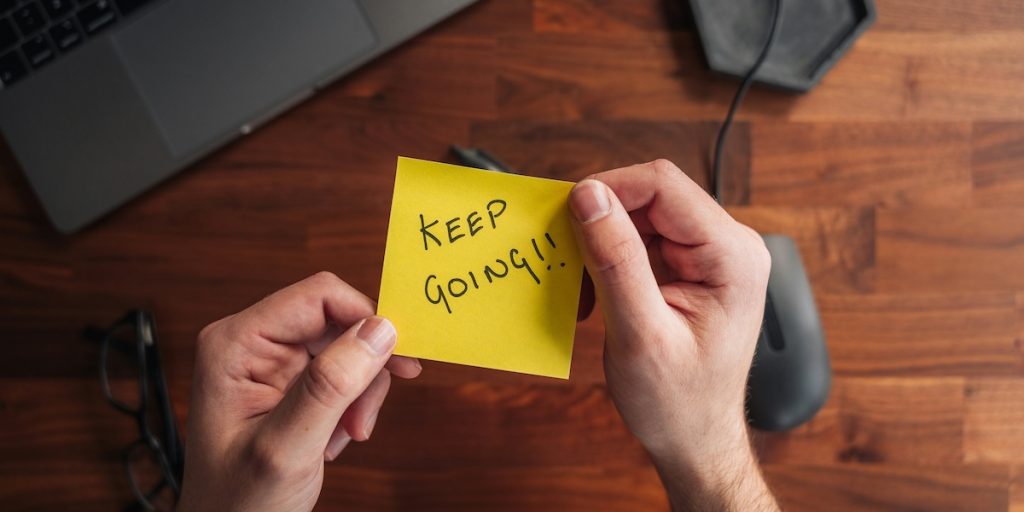Andrew Huang is a partially deaf Toronto-based musician, music/video producer, and YouTuber with over two million subscribers. Huang has released over 2,000 songs in a massive range of genres, and his YouTube content runs the gamut from music education to equipment reviews to interactive projects with fans and other industry titans.
Below, Andrew shares five key insights from his new book, Make Your Own Rules: Stories and Hard-Earned Advice from a Creator in the Digital Age. Listen to the audio version—read by Andrew himself—in the Next Big Idea App.
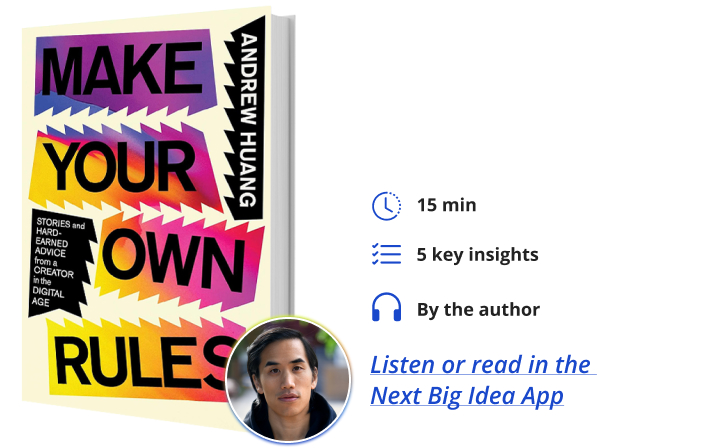
1. Openness.
If you realize that anything, large or small, is treated as a default, a norm, a convention, the way everyone else does it, or how it’s always been done, that’s something worth questioning. That is an area where there is probably opportunity. If you’re presented with what appears to be a binary choice, examine whether that’s really true. Culture and society frame many things as mutually exclusive when in fact they can co-exist. They can be different facets of the same person or different approaches you can take at different times.
I grew up Asian in a very white Canadian city and was thus treated differently by my teachers and classmates. While it sometimes stung to be excluded or ostracized, I later realized it gave me a perceptive advantage. Others could fit themselves into certain molds to be more accepted by their peers. Because of how I looked, I wasn’t able to find acceptance regardless of what I did, so why bother trying to fit in at all? I got a head start on doing things my own way because it was the best option available to me. I spotted countless arbitrary norms or expectations that I simply sidestepped if they didn’t suit me. When I eventually brought that openness into my career, it allowed me to flourish.
Before e-commerce platforms were anywhere near popular, I built an online business by using eBay to auction my music production services. Before social media existed, I grew an online fanbase by creating unique, audience-participatory work that was compelling to share via word of mouth. When most musicians were still thinking in terms of record deals and touring, I dedicated myself to YouTube. Most people at the time considered it a repository for cat videos and memes, but I saw a level playing field for the arts and a direct and instant connection between any creator and their audience.
Tap into that openness that allows you to see things for what they are or what they could be—not just what the world around you says they are.
2. Creative contradictions.
The creative process is rife with conflicts, and a large part of your creative style lies in where you strike the balance between them. Again, the world is constantly telling us that things are mutually exclusive, when in fact many can coexist. Embrace the dualities and the spectrums. Here are some examples.
First, you need to create and destroy; there is growth and decay. For everything beautiful and complete, a mountain of material has been thrown away, lost, or left in a drawer. There are countless ideas that didn’t work or didn’t fit, bad takes, mediocre sketches, loose ends, dead ends, and things that were just forgotten about. It’s okay. All of this is fertilizer and soil. You won’t have a lush garden without it.
“There’s a time for exploring new things and trying out ideas where you have no clue what will happen.”
Second, creation is both sacred and casual. Take creative time seriously. Approach it with reverence. For me, it’s essential not only to my job but to my mental and spiritual health. At the same time, I’m not always precious about what I create. Usually, the best ideas happen when I’m having fun, going with the flow, and throwing ideas around with the nonchalance of a casual conversation.
Third, be really messy and really organized. There’s a time for exploring new things and trying out ideas where you have no clue what will happen. There’s also a time to be deliberate and exacting and work toward specific outcomes. If you tend to be meticulous and methodical, perhaps you could benefit from occasionally taking a looser approach. If you always think it should be a good time and lose interest when it comes to finishing a project, you might be surprised by what happens when you (sometimes) get serious about it.
3. Every opinion exists.
Engagement on social media—interaction in the form of a comment, like, share, etc.—is usually under five percent, and very often not even one percent. So, if a thousand people see something you’ve posted, you should expect to see fewer than 10 comments. This all means that the average person in your audience does not leave a comment, so when someone does, they’re often compelled by a stronger-than-average response to your work.
Imagine a bell curve on a graph where the vertical axis is the number of people who saw something you shared, and the horizontal axis represents how much they liked it. The large middle portion of the bell is where most people are, the average response to your work. The comments tend to come from the edges; the people who loved it or hated it. People who were so touched, inspired, entertained, offended, or disgusted that they wanted to let you know about it. So, every comment must be taken with a grain of salt—especially the salty ones. You equally cannot pay heed to the people calling you an unparalleled genius or an embarrassing failure.
If there’s one thing I’ve learned from the micron of fame I’ve experienced, it’s that you really do have to live your life for yourself. I think we all understand on some level that it’s healthier not to care what other people think of you; time and again, I’ve been shown this in full force by having thousands of people tell me their thoughts about me and my work. At the extreme ends of that bell curve, almost every possible opinion exists.
Sometimes, I notice exact opposite reactions to the same song, video, or social media post. I began collecting some of these conflicting couplets. Keep in mind, these aren’t just random comments that happen to disagree with each other. Every one of these was found beneath the same post as its partner—they show different people responding to the same piece of media.
“You have the voice of an angel” compared to “his singing is soooo bad.”
“Andrew has got to be the most genuine creator out there.” In contrast, “I can’t stand how fake this guy is.”
And my personal favorite: “his eyes are too close together” and “his eyes are too far apart.”
“Every comment must be taken with a grain of salt—especially the salty ones.”
Beauty is in the eye of the beholder. Everything else is also in the eye of the beholder. (And my eyes, I assume, must be the perfect distance apart.)
Who should you listen to? Yourself, with occasional input from someone you trust. A bit of sage advice or constructive criticism from someone who knows your field and knows you is worth the world. A stranger taking 10 seconds to type something negative about you is nearly meaningless. You don’t know where they’re coming from. How they respond to you or your work is much more about them than it is about you. Assumptions and miscategorizations run rampant in our daily interactions in general; this is only exacerbated by the complications of online communication.
Giving credence to any feedback from strangers, the good or the bad, is another way we fall into acting (or not acting) based on external values. If you’re trying to prove yourself, you’ll never run out of people to prove yourself to. If you need validation from outside yourself, you’ll never stop needing it. If you give in to fear about how others will respond to you or your work, it might protect you from some discouragement or disappointment, but it will also definitely prevent you from fully flourishing in the way that only you can.
Sometimes people ask me how to overcome the fear of putting yourself out there. They’re worried about what people might think or say, that their work isn’t as good as they hope it is, or that who they are is too weird or different to be accepted. Maybe I got a head start on thickening my skin because I was unavoidably, visibly different from the kids I grew up with. But it’s more than that as well. I do sometimes still fear what people will think of me or say about me. The greater fear, though, is imagining spending a lifetime not being true to myself.
4. Escaping perfectionism.
It’s hard work to finish a project. It’s easier to endlessly tinker and fool yourself into thinking you’re making progress with your minuscule changes. At some point, you’re making adjustments that won’t tangibly improve anyone’s experience of your work—or even be noticed at all. This tendency doesn’t come from a bad place. As creative people we’ve all put time and work into our craft, and seen improvements as a result. It’s worth striving to make something special and aligned with your vision. But it’s wise to recognize the point of diminishing returns while it’s still in your rearview mirror, or you risk ending up in that perfectionist wasteland where you can’t tell what’s good or not—a difficult place to escape.
Perfectionism might even be self-sabotage. If you call a piece done, then it’s open to judgment. If it’s never finished then it can never be released, and if it’s never released then there’s no chance for it to fail. But then, of course, there’s no chance for it to succeed. There’s far less room for you to grow. If you’re spending all this time fiddling with the same aging ideas, how much capacity do you have to let in fresh inspiration and build on your skills?
Lastly, perfection does not exist. You can always search for something to improve. Your taste and context can also change. What you think is fantastic right now might feel lackluster in the future. What you think is the best creative choice today might feel off tomorrow. For those of us who hold ourselves to very high standards, or find ourselves in that place of endless fine-tuning, it’s worth internalizing this.
I have a cue now that tells me I’m finished with something. It’s when I start making volume adjustments of less than half a decibel. If I’m so zoned in on a project that I think there’s an improvement to be made at this level, I know it’s the kind of thing that will go completely unnoticed by listeners, including me, the minute I step away from the computer. And a lot of the time, even at the computer, I’m probably fooling myself that I can perceive the change. Half a decibel is a barely noticeable difference in volume that a skilled listener, with certain sounds, if they’re paying attention, can maybe distinguish.
In your work, try to find something like this that sits at what psychologists call a “difference threshold”—the point along the spectrum or the resolution at which you can no longer reliably detect change. Knowing you’re working there can nudge you into considering that you may have crossed over from productivity to perfectionism.
5. Weakness might be strength in disguise.
I was a good musician in high school, but after I was accepted into a post-secondary music program, I was suddenly and exclusively surrounded by other kids who were great at music in high school. Almost all my classmates had phenomenal talent, or tremendous dedication to their craft, or both. Much as I do now, I flitted between a wide range of usually experimental and exploratory interests. I’d applied to York University for classical composition—the only music program offered by the school at that time that didn’t require a live audition on an instrument—because the dexterity and expression in my playing were far behind that of my peers. In high school, my talents in music made me believe I had something special; in university, I was intimidated by how good everyone else was.
But I was unconventional, and the ways I was different proved to be my greatest strengths. Waves of students poured in and out of the always-booked practice rooms I never even entered. I would instead be in a deserted section of the library, seeking out documentaries and recordings of early electronic music, building an understanding of a hugely consequential slice of music history that is rarely taught in schools. I could never hold a candle to my fellow students in performance, but few were interested in creating music with a computer at the time. Starting with recording my friends in my basement apartment, I began to carve out the music production career that eventually led me to a sizable audience and lots of commercial work, while their opportunities were—and, in some cases, still are—limited to playing cover songs on pub nights.
“If something atypical or unorthodox comes naturally to you, finding a way to work with it rather than against it can suddenly make things much easier.”
I’ve learned to lean hard on specific weaknesses. Many things I once considered flaws or disadvantages about myself I’ve been able to use to my benefit. I’m not saying that I don’t work to better myself, and certainly I have natural tendencies that don’t serve me as well as others might. But if something atypical or unorthodox comes naturally to you, finding a way to work with it rather than against it can suddenly make things much easier.
From that place of profound openness, many supposed weaknesses can be viewed as excelling at something we don’t usually consider. The greater the weakness, the better you are at its counterpart! Do I overthink things and obsess over details? Yes, often. But that’s the same part of me that’s allowed me to iterate prolifically on ideas and execute them with precision. Am I a naturally gifted vocalist? No—and folks in my audience remind me of this nearly every time I incorporate my singing into a project. But I’ve seen a tendency in many musicians with beautiful voices to rely heavily or even exclusively on them, which can limit them in other ways.
The development of a lot of my musical skills and knowledge came in part because I was compelled to work harder on elements that didn’t have to do with my physical capabilities. As I’ve gotten to know other successful artists and creators, I’ve found that this strength/weakness paradox is quite common. For example, the frontman of a popular band, who was eventually prevented from touring due to health issues, pivoted and became an in-demand songwriter, working daily with A-list artists from his home. A YouTube creator struggling with attention deficit disorder learned to collaborate and delegate, enabling him to create more, better, and higher-performing content than he ever could have alone. Go with the flow wherever you can, and let the motion and momentum that are already in place work for you.
To listen to the audio version read by author Andrew Huang, download the Next Big Idea App today:
